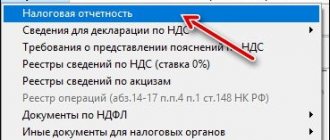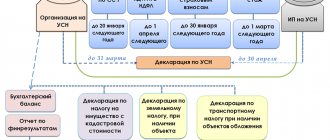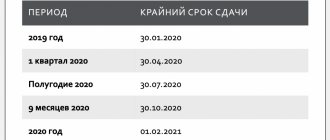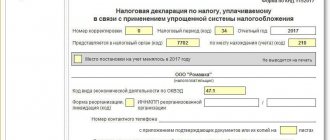Types of reports
The legislation of the Russian Federation provides for private businesses to submit reports to several authorities. The types of reports, submission deadlines, and completion rules depend on the form of taxation and the availability of employees at the enterprise. Thus, according to Order of the Ministry of Finance of Russia No. 66 n dated 07/02/2010 (as amended on 03/06/2018), the main types of declarations for all individual entrepreneurs are:
- Tax returns : forms 2-NDFL, 3-NDFL, 4-NDFL, 6-NDFL, VAT.
- Financial or accounting statements. Includes a balance sheet (OKUD 0710001), financial results (OKUD 0710002), reports on changes in capital (OKUD 0710003) and on the movement of material assets (OKUD 0710004), 4-FSS.
- Statistical reporting. These are questionnaire forms that entrepreneurs submit monthly or quarterly to the Federal Statistics Service of the Russian Federation (Rosstat). The contents of the questionnaires help to identify the main problems in the field of trade and services in a certain sector, as well as track the timely payment of funds to the tax budget. Mandatory forms for submission regardless of the taxation scheme (SNO): 1-IP, 1-IP (trade), PM-industrial.
- Zero reporting. The report is submitted if there were no cash turnovers in the tax period. If the enterprise has employees, then reports on insurance premiums are submitted to the Pension Fund (SZV-M) and the Social Insurance Fund (4-FSS) in any case.
According to Art. 6 Federal Law No. 402 of December 6, 2011 (as amended on July 29, 2018), an individual entrepreneur running a private practice is allowed not to keep accounting records, and accordingly, nothing needs to be submitted. But the businessman is obliged to keep records of the receipt of funds and expenses, which is reflected in a specialized book.
Sometimes it is more convenient for an entrepreneur to report to Rosstat and the Federal Tax Service, then it is preferable to use a simplified method of accounting, which includes reporting financial documentation.
Taking into account tax obligations to the state, the businessman reports to the tax authorities, as well as Rosstat, with a minimum reporting package.
What reports do individual entrepreneurs submit with and without employees?
The Tax Code of the Russian Federation explains each type of taxation scheme and types of reporting documentation. The entrepreneur submits declarations and fills out forms for tax and statistical services, depending on the SSS.
Not every private business owner can use a certain scheme, since some areas of employment are not designed for a specific aid to navigation system. For example, agricultural production is carried out only according to the Unified Agricultural Tax. The table below explains the types of reports that correspond to each type of tax scheme.
| SNO | Mandatory reporting for individual entrepreneurs without employees | Additional reports of individual entrepreneurs with employees |
| USN (Chapter 26.2 of the Tax Code of the Russian Federation) |
|
|
| PSN (Chapter 26.5 of the Tax Code of the Russian Federation) | ㅡ |
|
| UTII (Chapter 26.3 of the Tax Code of the Russian Federation) |
|
|
| Unified Agricultural Tax (Chapter 26.1 of the Tax Code of the Russian Federation) | KND 1151059 |
|
| BASIC |
|
|
A zero declaration is submitted by individual entrepreneurs working under the simplified tax system, according to the approved form KND 1152017. When funds flow during the tax period, the form is a full report, and if the indicators are zero, it is zero.
Reporting for individual entrepreneurs
If an entrepreneur does not have staff, he pays insurance premiums only for himself and does not need to submit any additional reports. However, if an individual entrepreneur has a staff of employees, then the number of reports that must be submitted increases sharply.
In 2021, personnel contributions, which were previously paid to the Pension Fund and the Social Insurance Fund, are under the control of the Federal Tax Service. The tax office requires individual entrepreneurs to provide four reporting forms.
If there is a staff of employees, the number of reports that must be submitted to regulatory authorities increases noticeably
Calculation of insurance premiums
In 2021, the SZV-M calculation is submitted quarterly to the tax office (and not to the Social Insurance Fund, as before). This calculation includes information on contributions for individual entrepreneurs for health, social and pension insurance.
Reporting in form 2-NDFL
The declaration is submitted to the tax authority once a year, but for each individual entrepreneur. This certificate contains information about the income received by an individual, deductions provided to him, as well as the amount of tax withheld for the previous reporting period.
Information on the average number of employees
Data on the average number of employees is submitted to the Federal Tax Service once a year. Information on the number of employees is necessary for the tax office primarily because this is one of the indicators that is used when calculating some taxes. And it is also a form of control over preferential regimes, since the use of some of them imposes restrictions on the number of staff.
Form 6-NDFL
6-NDFL is a new reporting form for employers, which is submitted once a quarter. Just like the 2-NDFL certificate, it contains information about the income received by individuals. It differs from the 2-NDFL certificate only in that it is submitted not for an individual employee, but for the entire staff at once.
In 2021, individual entrepreneurs will submit two reports to the Pension Fund of the Russian Federation.
Information about the length of service of the insured person
This report is provided once a year, and on the basis of it the Pension Fund will receive information about the periods of work of an individual and about the insurance premiums accrued for him.
SZV-M report
SZV-M is a new reporting form that was introduced in April 2016. Submitted monthly and contains information about the employer and employees. The introduction of this form is due to the fact that the Pension Fund needs information about working pensioners in order to know which of them should not have their pensions indexed.
4-FSS
Individual entrepreneurs need to submit only one report to the FSS - 4-FSS. It reflects accrued and paid insurance premiums for employees. As of this year, only one section remains in the reporting form - contributions for injuries. If the individual entrepreneur does not conduct any activity, then contributions are not calculated and a zero report is submitted, to which it is better to immediately attach the necessary explanations about the reasons for submitting the zero report.
Entrepreneurs who are on OSNO and have hired employees have to fill out quite a lot of different reports
What is KUDiR
KUDiR ㅡ book of accounting of income and expenses, necessary for participants of the simplified tax system. Entries are made in the book in accordance with the requirements of Order of the Ministry of Finance of Russia No. 135 n dated October 22, 2012 (as amended on December 7, 2016). The document includes a title page and five sections, which reflect:
- sales revenue and costs of the enterprise;
- calculating the costs of purchasing and creating funds, which are taken into account when calculating the tax base;
- calculation of the loss in the total amount, which leads to a reduction in the duty;
- other expenses that reduce the amount of tax;
- a trade tax that reduces the tax that is calculated to be paid.
Depending on the type of “simplified” document, the entrepreneur fills out different departments of KUDiR. On “income” ㅡ 1 and 4, on “income minus expenses” ㅡ 1, 2, 3. The fifth is drawn up by entrepreneurs who are subject to the trade fee.
KUDiR is maintained electronically or on paper. Every year a businessman starts a new book, and prints out the old one, laces it and numbers it. On the final page, the end date is indicated, the entrepreneur puts a signature and, if any, a seal.
Insurance premiums for workers
For individual entrepreneurs with hired employees, quarterly submission of insurance data is also required. For this purpose, the 4-FSS reporting form was specially adopted. It contains literally all the information on insurance payments entered into the Social Insurance Fund for each employee.
Moreover, those organizations whose average number of employees does not exceed 25 people must submit reports in paper form. For those with more than 25 people, the report can be submitted electronically. And each of them has its own deadlines - in the first case it is the 20th of the month of the next quarter, and in the second - the 25th.
Report submission deadlines
The businessman is not warned about the deadlines for filing declarations. Each report is submitted within the period approved by the Legislation of the Russian Federation. The period is also affected by the type of aid to navigation. The balance sheet OKUD 0710001 and reports on financial results OKUD 0710002 are submitted at the end of the year. Only those individual entrepreneurs who conduct accounting submit reports. The main declarations for each tax scheme are submitted within the deadlines approved by the Tax Code of the Russian Federation. Each declaration is submitted in the month, quarter or year that follows the reporting year. Deadlines for submitting reporting documentation for individual entrepreneurs:
- Declaration of the simplified tax system KND 1152017 ㅡ annually until April 30.
- PSN are reported only “by employees”, if any. These are reports from 4-FSS, SZV-M. The due dates are listed below.
- Declaration of UTII KND 1152016 ㅡ quarterly until the 20th of the month.
- Declaration of Unified Agricultural Tax KND 1151059 ㅡ annually until March 31 of the year.
- The main declaration for OSNO ㅡ VAT ㅡ is submitted quarterly by the 25th of the month.
Other reports:
- 3-NDFL ㅡ until April 30 of each year.
- 4-NDFL is submitted upon receipt of the first revenue.
- 6-NDFL ㅡ until the last day of the month following the reporting period.
- 4-FSS “on paper” ㅡ monthly until the 20th day of the month following the reporting month; in electronic form by the 25th day of the month following the reporting month.
- SZV-M ㅡ before the 15th of each month after the reporting month.
- 1-IP ㅡ annual report, which is submitted no later than March 2 of the year following the reporting year.
- PM-PROM ㅡ monthly no later than the 4th.
The deadlines for filing declarations change almost every year. Therefore, it is worth monitoring current information on specialized resources.
Tax reporting that entrepreneurs are required to submit in 2021
Traditionally, reporting requirements for individual entrepreneurs are determined by the exact tax regime applied by the entrepreneur, as well as whether hired labor is used.
The procedure and deadlines for submitting reports are determined by the Tax Code of the Russian Federation
Individual entrepreneur on the general taxation system
The OSNO regime is quite complicated for individual entrepreneurs, as it requires the submission of a large number of reporting documents. Its advantageous difference from special regimes is that OSNO does not imply any restrictions on the number of employees, or on profit levels, or on types of activities.
Individual entrepreneurs who have chosen the general taxation system must pay personal income tax (see Articles 227, 229 of the Tax Code of the Russian Federation) and VAT (see Article 143 of the Tax Code of the Russian Federation) and submit the corresponding reports.
According to the law, a VAT return can be submitted exclusively electronically through an operator providing electronic document management, or using online services of the Federal Tax Service.
Table: reports that individual entrepreneurs with employees at OSNO submit to the Federal Tax Service
| No. | Reporting type | Taxable period | Deadlines | Submission Format |
| 1. | VAT declaration | Quarter | Until the 25th day (inclusive) of the 1st month of the quarter that follows the reporting period | Strictly in electronic version |
| 2. | Declaration 3-NDFL | Year | Until April 30 of the year following the reporting period | In paper version if the number of employees is no more than 100, or in electronic version |
| 3. | Declaration 4-NDFL | — | At the start of activity or no later than a month from the moment income changes by 50% in any direction | On paper or electronically |
| 4. | Information on the average headcount (SHR) | Year | No later than January 20 of the year following the reporting period | On paper or electronically |
| 5. | Calculation of 6-NDFL | Quarter | No later than the last day of the 1st month of the quarter following the reporting period | In paper form (if the SRF does not exceed 25) or electronically |
| 6. | Certificates 2-NDFL | Year | If the tax is withheld, then until April 1 of the reporting year. If not withheld, then until March 1 of the reporting year. | In paper form (if the SRF does not exceed 25) or electronically |
| 7. | Calculation of insurance premiums | Quarter | No later than the 30th day of the month following the reporting period | In paper form (if the SRF does not exceed 25) or electronically |
Table: reporting that an individual entrepreneur on OSNO without employees submits to the Federal Tax Service
| No. | Reporting type | Taxable period | Submission deadlines | Submission Format |
| 1. | VAT declaration | Quarter | Until the 25th day inclusive of the 1st month of the quarter that follows the reporting period | Only electronically |
| 2. | Declaration 3-NDFL | Year | Until April 30 of the reporting year | On paper or electronically |
| 3. | Declaration 4-NDFL | — | When starting a business or no later than 30 days from the date of income change by 50% in any direction | On paper or electronically |
Zero reporting
If during the reporting period the individual entrepreneur did not conduct work and did not receive income, he is still obliged to submit reports on time, but zero. For failure to provide it, the businessman will be fined. Individual entrepreneurs at OSNO without employees are required to submit zero reports with the following reports:
- VAT declaration (with filling out the title page, as well as section 1);
- Declaration 3-NDFL.
Individual entrepreneurs with employees include in zero reporting:
- Declaration 3-NDFL (with filling out the title page, as well as sections 1, 2),
- information about the SRF;
- zero settlement for insurance payments.
A zero declaration is submitted before April 30 of the reporting year.
Video: organizing tax accounting for individual entrepreneurs on OSNO
Special tax systems
The special tax regimes that are most attractive for individual entrepreneurs include:
- simplified (USN) system;
- patent (PSN) system;
- unified tax on imputed income (UTII);
- single agricultural tax (UST).
PSN
The simplest reporting is for individual entrepreneurs working using the patent tax system. There is no tax declaration for PSN, which is determined by the peculiarities of this system itself, when all fees are paid at the stage of purchasing a patent, the corresponding reports are submitted automatically.
simplified tax system
Individual entrepreneurs using the simplified system send a declaration to the Federal Tax Service office at the place of registration after the expiration of the tax period, which is equal to a calendar year. Reports must be sent no later than April 30 of the reporting year. The simplified tax system declaration will have to be presented even when the enterprise did not have activities in the reporting period or if the individual entrepreneur is decided to close. If no activity was carried out, it is necessary to submit a zero declaration; when closing an individual entrepreneur, a declaration for the period that the company managed to operate before the closure. The simplified taxation system reporting form can be easily found on the Federal Tax Service website. Requirements for the format of a declaration submitted electronically are available for download. The current form, the procedure for filling it out, as well as the format for submitting it in electronic form are regulated by Order of the Federal Tax Service of Russia No. ММВ-7–3 / [email protected] dated 02.26.2016.
When generating zero simplified taxation reporting with the object “income”, you need to fill out the title page and sections 1.1, 2.1.1 of the declaration; for the object “income minus expenses”, fill out the title page and sections 1.2, 2.2. Some individual entrepreneurs (Moscow trade tax payers) will also need to fill out sections 2.1.2 and 3.
It is important to submit reports on time, since a delay of 10 days or more threatens to entail penalties (5–30% of the amount of unpaid tax for each overdue month, but not less than a thousand rubles, see Article 119 of the Tax Code of the Russian Federation) and even freezing of the individual entrepreneur’s current account (see. Article 76 of the Tax Code of the Russian Federation).
Video: individual entrepreneur reporting on the simplified tax system
UTII
Entrepreneurs on UTII submit reports at the end of each quarter, even if no activity was carried out. Reporting is submitted no later than the 20th day of the 1st month of the quarter that follows the reporting one. In addition, individual entrepreneurs and employees on UTII submit forms 2-NDFL, 6-NDFL and SRCh.
There is no zero reporting on UTII. The corresponding declarations are always submitted with non-zero indicators. If an individual entrepreneur on UTII does not receive income from his activities, the state recommends changing the taxation regime. Reporting may be submitted in paper form (in person, by a valuable letter with a list of attachments, through a representative) or in electronic form (via online channels).
An individual entrepreneur on UTII submits reports to the branch of the Federal Tax Service where the actual activities of the company are conducted. If it is not possible to determine this place unambiguously, reports can be sent to the Tax Service at the place where the individual entrepreneur was registered.
Video: how to fill out a UTII declaration
https://youtube.com/watch?v=5Yj06Z2WQeA
Unified agricultural tax
Individual entrepreneurs working using the unified agricultural tax submit reports on the results of the calendar year no later than the last day of the 1st quarter of the year that follows the reporting one.
Reporting on the Unified Agricultural Tax must be submitted in paper or electronic form and sent to the regional tax office at the place of registration of the businessman.
Video: Unified Agricultural Tax System
Reporting for hired personnel
Starting from 2021, for individual entrepreneurs on OSNO, using the labor of hired personnel, an additional report will appear to the tax office, which is responsible for insurance contributions to the Pension Fund and the Social Insurance Fund for hired personnel and reflects information on payments made for pension, social and medical insurance of employees. The calculation of insurance premiums must be submitted to the Federal Tax Service inspection at the place of registration. Contributions for injuries are not included in the report and, as before, are paid to social insurance, reports are sent there. The execution of the calculation is regulated by the order of the Federal Tax Service No. ММВ-7–11/551 dated 10.10.2016. The calculation form is available for download.
Reporting on insurance payments in 2021 is submitted every quarter no later than the last day of the month following the reporting quarter. To submit reports for the first quarter of 2018, the deadline for submitting documents is 05/03/2018.
For violation of the deadlines for submitting reports, the individual entrepreneur is supposed to be fined in the amount of 5 to 30% of the amount of outstanding payments for each month of delay, but not less than one thousand rubles.
Penalties for late submission
According to Art. 119 Federal Law No. 146 of July 31, 1998 (as amended on August 3, 2018) of the Tax Code of the Russian Federation, part 1, if an individual entrepreneur does not submit one or another tax return on time, then the businessman is subject to a fine of 5% of the accrued duty amount. In case of long delay ㅡ more than a month ㅡ 30% for each overdue month, but not more than 1000 rubles.
According to Art. 13.19 Code of Administrative Offenses of the Russian Federation, punishment of individual entrepreneurs for late statistical reporting (PM-PROM, 1-IP, 1-IP (trade)):
- for a primary offense ㅡ 10,000 − 20,000 rubles;
- for secondary ㅡ 30,000 − 50,000 rubles.
Delay in filing reports with the Pension Fund of Russia (SZV-M) is punishable by a fine of 500 rubles for each insured citizen. Conducting a private business, regardless of the taxation scheme, does not reduce the entrepreneur’s responsibility to tax and statistical authorities, but reduces the requirements for the amount of documentation. The choice of SNO directly affects reporting, but not every taxation scheme applies to the chosen area of activity.










